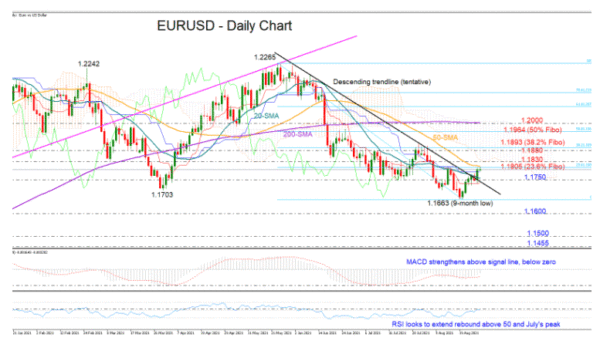EURUSD closed decisively above the two-month-old resistance trendline and the 20-day simple moving average (SMA) on Friday following some dovish remarks from Fed Chair Jerome Powell at the Jackson Hole symposium.
The trendline breakout, which sent the price as high as 1.1809 on Monday, raised optimism that the latest rebound could see further continuation. Yet, another challenge needs to be addressed to confirm additional upside corrections.
Specifically, the price needs to overcome the 23.6% Fibonacci retracement of the 1.2265 – 1.1663 down leg and the 50-day SMA, both at 1.1805, and then pierce the lower boundary of the Ichimoku cloud around 1.1830, which cancelled upside corrections back in June. If efforts prove successful, the pair may attempt to close above the 1.1880 barrier and run beyond the 38.2% Fibonacci of 1.1893. Any violation at this point would negate the downward pattern in the short-term picture, likely boosting positive momentum up to the 50% Fibonacci of 1.1964 and the 200-day SMA at 1.2000.
In momentum indicators, the RSI is looking to extend its latest rebound above its 50 neutral mark, but it has yet to print fresh highs above July’s peak. Likewise, the MACD is distancing itself above its red signal line, though it is still below the zero line, both suggesting that downside risks have not entirely faded yet.
Should sellers take control, immediate support could occur around 1.1750, where the broken trendline, the 20-day SMA and the red Tenkan-sen line converge. Failure to bounce here could see the price diving towards the 1.1663 low, while lower, the decline could falter near the 1.1600 psychological level.
Summarizing, EURUSD could face more upside pressures in the near term, though a significant close above 1.1800 – 1.1830 is required to activate new buying orders.














